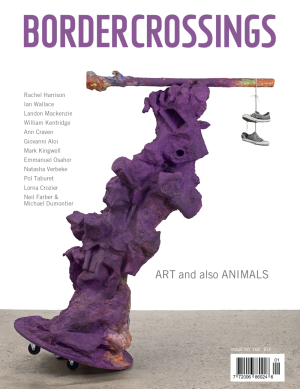Video, Vidi, Vici
After viewing Rebecca Horn’s 1993 mid-career retrospective, “The Inferno-Paradiso Switch,” a number of times, I came away from the exhibition with the express conviction that nobody could ever again so thoroughly inhabit the venerated precincts of the Guggenheim Museum. As if to prove that conceit manifestly wrong, along comes “The Worlds of Nam June Paik,” the Korean-born artists first States-wide retrospective since 1982. And just as Horn had deployed her works in a lyrical crescendo up Frank Lloyd Wright’s helix to the summit, so too has Paik, in collaboration with curators John G. Hanhardt and Jon Ippolito, orchestrated his multitudinous productions into a symphonic whole. The analogy is all the more fitting given the fact that Mr. Paik launched his career as an avant-garde musician in Germany, studying and performing with the likes of Thrasybulos Georgiades and John Cage. It would seem as though Nam June Paik has operated as a combination antenna and tuning fork for global culture ever since.

Nam June Paik, sketch for Modulation in Sync, 1999, acrylic on colour photograph, 24 x 20”, Solomon R. Guggenheim Museum, New York. Collection of the artist. Photograph: Ellen Labenski. Courtesy Solomon R. Guggenheim Museum, New York.
The exhibition’s centrepiece, Modulation in Sync, 2000, is an arresting site-specific installation which incorporates two commissioned laser-projection works: in the first, Jacob’s Ladder, a laser is projected and the beam is reflected by mirrors so that it appears to ascend in a succession of steps through a waterfall which plunges from the museum’s ceiling; in the second piece, Sweet and Sublime, a laser projects continually changing 3-D shapes onto a screen mounted on the Rotunda ceiling. Below, on the lower level, Paik has arranged 100 video monitors facing upwards at varying angles and broadcasting a pulsating array of his video images on multiple channels. As a complement, large-screen video projects are installed along the outside of the ramps encircling the Rotunda, which serve to amalgamate the elements on the floor, walls and ceiling of the building. The various prospects from which to view the work, combined with the flash and glow of the literally hundreds of TV sets, monitors and projections, transform the Guggenheim into an immense cave-dwelling, a strangely warm and intimate space, considering the overwhelming presence of all that technology. This sense of intimacy is precisely what is at the heart of Paik’s work; the technology is not merely in the service of humanity, it is an extension of it, a way of probing its innermost secrets, its outermost vanities. The message is the medium.

Family of Robot: Grandmother, 80 3/4 x 50 x 19” and Family of Robot: Grandfather, 101 X 73 X 20 1/2”, 1986, one-channel video sculptures with monitors and vintage television and radio cabinets, 30 min., no sound. The Robert J. Shiffler Foundation, Greenville, Ohio. Photograph: Cal Kowal. Courtesy Carl Solway Gallery, Cincinnati.
This is evident through the entire itinerary of Nam June Paik’s work as it makes its way from the 1960s and ’70s to the present along the spiral ramps of the Guggenheim. Works from the jocular Candle TV, 1975 (a hollowed-out TV casing holding a single burning candle), to One Candle (Candle Projection), 1988 (a videotaped burning candle projected in several monitors and onto the outer walls); from the updated version of TV Garden, 1975 (countless monitors of varying dimensions flashing from the camouflage of potted plants), to Video Fish, 1975 (a row of 52 aquariums with live fish in front of 52 monitors projecting assorted images including other fish and Merce Cunningham dancing), and including Mongolian Tent, 1993 (a full-scale yurt with dirt floor on which three Buddha statues watch Beuys Projection, 1990—a Beuys performance filmed by Paik), all are eloquent testimonials to this artist’s vigorous preoccupation with the structure and ideology of television and his ability to convey his findings with wit and panache—a much-needed commodity in the current cultural climate. At the museum’s apex, a section of the Tower Gallery has been set aside as a tribute to the late Charlotte Moorman, a classical cellist and frequent Paik collaborator. It seems it was her arrest for a topless performance of Paik’s Opera Sextronique, 1967, at the Filmmaker’s Cinématheque in New York, which occasioned Paik’s design for TV Bra for Living Sculpture, 1969. Here, affixed to her breasts is a pair of miniature monitors playing images of the musician bowing her instrument. More than 30 years later, such humour and inventiveness still strike a resonant chord amid the clamour of controversies surrounding censorship of the arts by the powers that be. ■
“The Worlds of Nam June Paik” was on exhibition at the Solomon R. Guggenheim Museum, New York, from February 11 to April 26, 2000.
Robert McGee is a poet and critic. He contributes regularly to Border Crossings from Brooklyn, New York.

